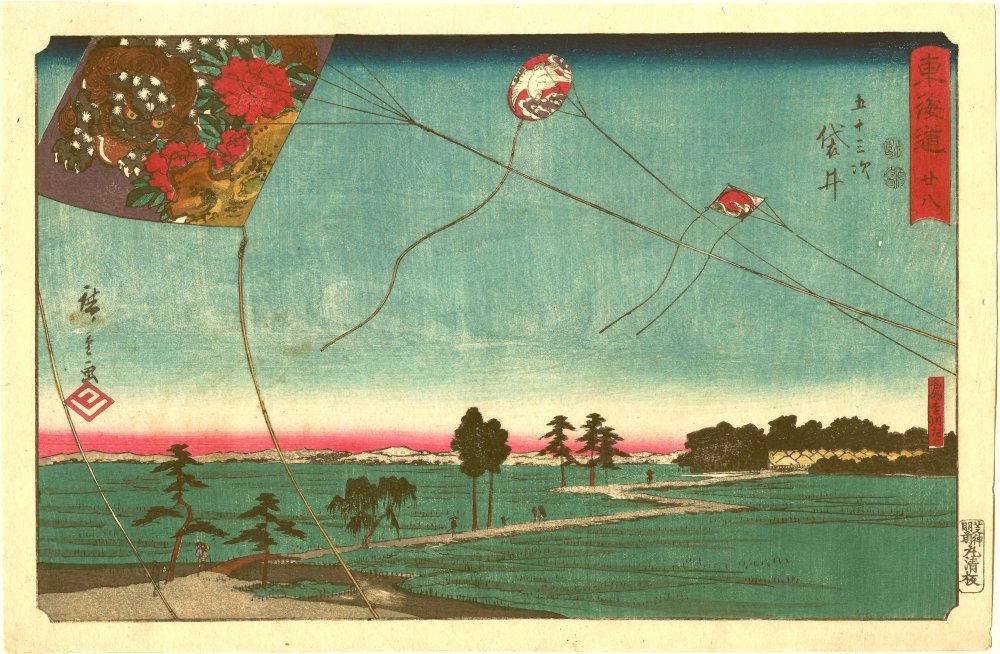| |
Hiroshige(1797 - 1858)"No. 28 - Fukuroi: Famous Kites of Tôtômi""The Fifty-three Stations of the Tokaido"(Tôkaidô - Gojûsan tsugi) also known as the Reissho Tôkaidô |
|

"No. 28, Fukuroi: Famous Kites of
Tôtômi"
(廿八 袋井 名物遠州凧 Fukuroi, meibutsu Enshû tako)
Series: Famous Sights of the Fifty-three
Stations of the Tokaido
(東海道 五十三次 名 所図会 Tokaido Gojûsan tsugi meisho zue)
(also known as the Horizontal- or
Reissho-Tôkaidô Edition)
1847
Comment - Beautiful design featuring
the famous Tôtômi Kites of Fukuroi. Fukuroi is Station No. 28
of the Tôkaidô
road. The dominant upper left kite is an edo kite ("Edo-tako",
"江戸凧") with both of his long tail ropes nearly touching the
ground. The kite is decorated with a stylized lion and a
chrysantemom flower arrangement. A near identical design is
applied at the dominant Fukuroi
Circular kite by Hiroshige-II, the disciple and heir of
Hiroshige (I). The smaller kite in the centre of this Reissho
edition is a Fukuroi
Circular kite (Fukuroi no Maru-dako, 袋井の丸凧) and contains
a crane crest. The edo-kaku kite on the right
carries a Japanese flag with splashing waves, symbolizing
Japan's maritime bondedness. The design is nearly identical to
the above mentioned Fukuroi
print of Hiroshige-II, or Hiroshige-II's Shin Ohashi print.
In the foreground, two wanderers reach a small wooden bridge, crossing over to a dam, separating vast rice paddies. The kites are floating high above, where workers on the zigzag dam pause to look up and enjoy the sight.The sky has a beautifully shaded deep blue "bokashi" sky at the top, and as the sun begins to set, along the horizon a rosy glow below. Sparse pine trees grow on the dam, leading to a small hamlet. Several huts, whose grass thatched roofs are contrasted by the surrounding dark greenish vegetation.
The red cartouche upper right shows the correct title "Tokaido 28" ("Tōkaidō nijūhachi", "東海道 廿八"). The number "28" is written as "廿八", the short version for "二十八". left to the title cartouche are two circular censor seals (Kaiin, 改印) belonging to the censors Mera (米良) and Watanabe (渡辺). Left to the two seals is the series title "Fifty-three Stations" (Gojūsantsugi, 五十三次) and the station's name "Fukuroi" (Fukuroi, 袋井). The red cartouche right, below the kite lines is unread, may be "examine each item" (各物をりぞて, Kaku-mono ori zote).
Series
- The current landscape (horizontal) format Tokaido series is
commonly known as the “Reissho”
series since it uses clerical script (lit. Chinese:
'LiShu'; Japanese: 'ReisSho'). 'Reissho' (隷書) is a fontstyle
type of script developed in China during the Late Han dynasty
(20/22 AD ~ 220 AD) and made popular during the Chinese
Warring States period. It was used by Hiroshige to lend a
sense of formality and antiquity for the titles of each print.
The Gyosho-, Tate-e-, Jimbutsu-, and this Reissho- or Edition of "Famous Sights of the Fifty-three Stations" also contain kites from Fukuroi Station. For information about other series of Hiroshige, refer to HIROSHIGE's "Tokaido" and other Series.
Artist - see Biography
Signature - Hiroshige ga 広重画, center left, above his red "Hiro" seal
Publisher - Maruya Seijirô ( (丸屋清次郎); address and name of the printshop are written in the cartouche lower right margin (Shiba Shinmeimae Marusei Ita, 芝神明前 丸清板)
Image Size - horizontal (yoko-e) ôban; 21.5 x 33.3 cm (8 7/16 x 13 1/8")
Copyright 2008 ff: Hans P. Boehme